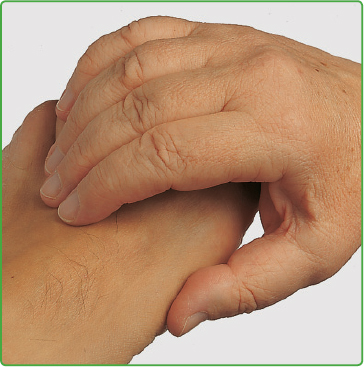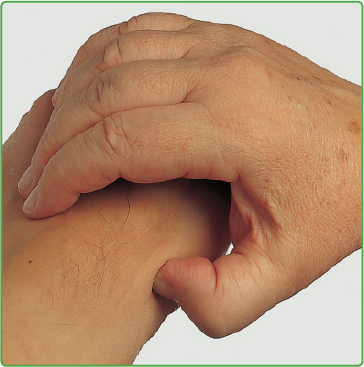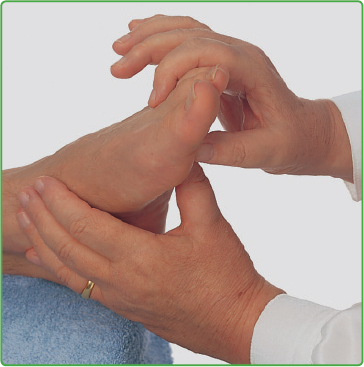3 Basic Therapeutic Grips: Touching, Treating Although, on a superficial level, it would also be possible to perform reflexotherapy of the feet (RTF) with technical instruments, I have opted for the manual approach, because the need for interrelationships based on the quality of human touch inevitably increases with the mechanization of therapeutic applications. Many people sense the imbalance which arises through lack of physical contact. They sense, usually subconsciously, that the very nature of a treatment, its innermost essence, is related to the secret of touch—in the words of Antoine de Saint-Exupéry: “It is only with the heart that one can see rightly; what is essential is invisible to the eye.” All manual forms of therapy can provide the direct interpersonal knowledge that being touched physically and being moved emotionally are closely interrelated. As a matter of fact, an electromagnetic energy field of a highly personal nature develops through touch. Two “open force fields” meet and strive for continual homeostasis (maintenance of functions in anatomical control systems). The common understanding of innervation is that a stimulus is conveyed to the receptors of the sensitive nervous system in the foot tissue by means of touch. In any attempt to explain the principle of “touch,” however, it should always be borne in mind that it cannot be described solely theoretically but can only be understood through personal experience. As a sensitive and personal instrument, the hand is best able to “understand” the foot when it is used in accordance with its anatomical structure. In this way, our muscles, joints and tendons are used in accordance with their natural function and without any risk of strain or damage. To begin with, I advise preferential use of the thumb as it is good at providing therapeutic stimuli, thanks to its special position and dominance. Although the four fingers, opposed to the thumb, are also in contact with the foot, their involvement is passive while the thumb is being used actively. Above all, the thumb being opposed to the index finger results in a wide, open space resembling a horseshoe or the letter “U” and this permits free and unrestrained movement. The grip technique employed today has been developed after years of practical experimentation to find the most appropriate manner of using the hand. In the early years, many therapists, including myself, applied excessive mechanical pressure, needlessly triggering complaints such as increased pain in the joints and muscles. The therapeutic grip is characterized by a rhythmical up and down movement which allows the hand to work for longer without strain because we employ the dynamic principle of strength and momentum while avoiding mechanical pressure. The rhythmic movement continues to act on the foot tissue and gives both patient and therapist the sensation that opposing—and yet coordinated—poles of movement and rest are combining to form a harmonious whole. Each grip therefore consists of an active and passive phase of roughly equal duration. The active phase consists of the following components: • After gentle touching of the zone, the first part of the treatment stimulus results from the arm being actively swung forward from the shoulder. This is similar to when a pendulum or a swing begins swinging (without any additional up/down movement of the wrist). • The forearm, wrist, and hand are in the mid-position between supination and pronation and form a natural horizontal line. As a result of the physiological position of the arm and hand thus obtained, the thumb is slightly pronated and can be used without strain. When the flat and relaxed, slightly radially positioned thumb pad has established contact with the foot tissue without any pressure, by swinging the arm forward, the distal phalanx of the thumb is gently unrolled passively and flexed significantly. The thenar eminence is completely relaxed until now and the tip of the thumb is still in gentle contact with the foot tissue, with a pressure equivalent to that exerted by the weight of a postage stamp. Fig. 3.4 Maximum activity of the tip of the thumb corresponds to conveying the stimulus deep into the tissue. Afterward, the thumb swings back into its passive initial position and begins the next step. • Only now does the tip of the thumb actively assume control, increasing the bend toward an angle of 90°. At the same time, the muscle tension in the thenar eminence also increases and the therapeutic stimulus of the distal phalanx is directed more or less vertically and selectively into the depth of the tissue. • The distal phalanx of the thumb is now bent as far as it will go, with compressed tension similar to the collective strength of an archer before he releases the arrow. This is the point at which the therapeutic stimulus is directed into the tissue. By spontaneously releasing the tension in the thenar eminence and the tip of the thumb, the arm can swing back passively and return the thumb to its neutral initial position. Again the thumb pad lies relaxed on the tissue and the fingers still support the foot from the opposite side. The next grip starts with the renewed, active, forward-swinging movement of the arm, leading again into the two phases of movement in the same sequence as before. The continuous alternation between tensed force and released calm produces an undulating rhythm which moves effortlessly, as if by itself, through the tissue of the foot millimeter by millimeter as a result of the impetus of the movement. It is usually more practical, and less work for the hand, to use the index finger on the dorsal parts of the foot. Here too, the approach is rhythmical; but the thumb now provides passive support on the opposite side. However, the swaying rhythm is not reflected in the pendulum movement of the whole arm here, as would occur with the thumb grip, but is transformed into an up-and-down movement of the wrist, similar to the swaying of a suspension bridge when walked across. The active phase is composed as follows: • The grip starts with a pronounced extension of the wrist (the back of the hand points to the forearm). • The entire index fingertip touches the tissue of the foot gently and without any pressure and the thumb provides support on the side opposite the fingers. • The wrist gently swings back into its neutral initial position while the index finger becomes more rounded as a result. • While the distal phalanx of the index finger gradually transfers the area of contact to the fingertip through the swinging of the wrist, it becomes increasingly active and in a vertical position it applies the stimulus deep into the tissue with increasing intensity. In a manner similar to the thumb grip, the built-up tension is then released; the index finger passively returns to its initial position and the wrist gently swings back into an extended position to start the next grip from there. The following applies to all fingernail shapes: Bending with the thumb and index finger grip is restricted to the point at which irritation by the nails causes too much discomfort, even if they are cut and filed short. Usually though, patients do not experience much pain caused by a fingernail—it is more often the therapist’s impression.
3.1 Touch
3.2 Grip Technique
3.2.1 Basic Thumb Grip
The Basic Thumb Grip and its Phases of Movement
Active Phase of the Thumb
Passive Phase
3.2.2 Basic Index Finger Grip
Active Phase
Passive Phase
Musculoskeletal Key
Fastest Musculoskeletal Insight Engine













